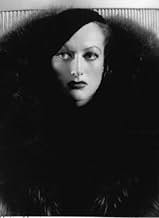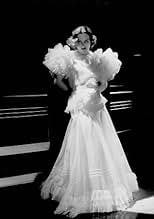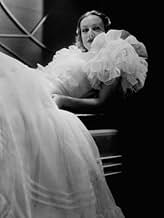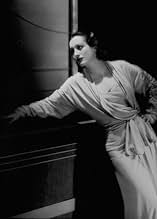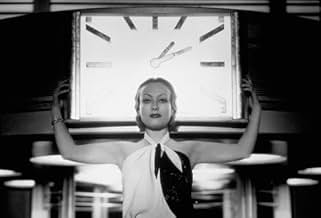Agrega una trama en tu idiomaA socialite begins a shipboard romance with a wealthy man, but is blackmailed by a former lover.A socialite begins a shipboard romance with a wealthy man, but is blackmailed by a former lover.A socialite begins a shipboard romance with a wealthy man, but is blackmailed by a former lover.
- Dirección
- Guionistas
- Elenco
- Premios
- 4 premios ganados en total
Sidney Bracey
- Waiter
- (sin créditos)
Edward LeSaint
- Dr. Sanders
- (sin créditos)
Edgar Norton
- Darrow's Butler
- (sin créditos)
Lee Phelps
- Dennis, Darrow's Chauffeur
- (sin créditos)
C. Montague Shaw
- Ship's Officer at Christmas Party
- (sin créditos)
Harry Stubbs
- Ship's Steward
- (sin créditos)
Charles Williams
- Reporter
- (sin créditos)
- Dirección
- Guionistas
- Todo el elenco y el equipo
- Producción, taquilla y más en IMDbPro
Opiniones destacadas
Long unreleased (and it's still hard to find a decent print), and thus notorious, "Letty Lynton" does not quite live up to this notoriety. It does have a great ending, the kind of pre-code ending that makes you want to sit up and clap, and a hard-to-watch scene of Joan Crawford being slapped around by a man, but otherwise it's an undistinguished story, unimaginatively presented. **1/2 out of 4.
... unlike so many lost or unavailable films. The plot initially seems not so unusual, especially for a Joan Crawford MGM vehicle of the 1930's. Joan plays a fabulously wealthy playgirl living in South America who decides to return home for a multitude of reasons - she wants to turn over a new leaf, she wants to make up with the mother (May Robson) who has been pushing her away all her life, but most of all she wants to get out of the grasp of a possessive lover (Nils Asther) that is smothering her and objectifying her to the point that she is frightened. She takes a ship home to New York, and on the way there falls in love with the charming heir Hale Darrow (Robert Montgomery). The two become engaged with the press waiting to snap their pictures as the boat docks, but as the picture is snapped, what does Letty see but the possessive lover she thought she left in South America, literally licking his chops for her and waiting for her to land.
Young Darrow knows nothing of Letty's past, Letty's mom still wants nothing to do with her, and as for her old lover, he's demanding she continue the affair or else he will publicize some torrid love letters she wrote. How does this all turn out? Quite unexpectedly, I'll tell you that much and I'll also tell you, thank goodness for precode where justice in the movies - as in life - didn't always have the predictable nature of a form letter like it did after 1934.
MGM threw its A-list talent at this one including Joan's gowns by Adrian, Lewis Stone with a short but important part at the end, and some first class character actors. The only thing that doesn't ring quite true is May Robson as Joan's mother. Robson's acting and characterization are perfect, but she was almost 50 years older than Joan, looks it, and it just doesn't seem plausible that they could be mother and daughter with that age difference staring you in the face. Still it's a minor quibble and I'd highly recommend watching it if you ever get the opportunity.
Young Darrow knows nothing of Letty's past, Letty's mom still wants nothing to do with her, and as for her old lover, he's demanding she continue the affair or else he will publicize some torrid love letters she wrote. How does this all turn out? Quite unexpectedly, I'll tell you that much and I'll also tell you, thank goodness for precode where justice in the movies - as in life - didn't always have the predictable nature of a form letter like it did after 1934.
MGM threw its A-list talent at this one including Joan's gowns by Adrian, Lewis Stone with a short but important part at the end, and some first class character actors. The only thing that doesn't ring quite true is May Robson as Joan's mother. Robson's acting and characterization are perfect, but she was almost 50 years older than Joan, looks it, and it just doesn't seem plausible that they could be mother and daughter with that age difference staring you in the face. Still it's a minor quibble and I'd highly recommend watching it if you ever get the opportunity.
As others have said, 'Letty Lynton' for a long time was a lost, or at least an unavailable, film and banned at the time for legal reasons. At long last it was re-discovered and is now available, though deserving of a much better print than it has and it is easy to see why it became notorious and also why others have become fond of it. 'Letty Lynton' had so much going for it, especially the cast and also that it was directed by Clarence Brown who did direct some great films.
It also did not deserve to be made unavailable for so long and even though it has been positively received since it deserves to be better known. Absolutely agree with others about 'Letty Lynton' being surprisingly very good, considering that quite a lot of lost but then re-discovered are not particularly good this film actually surprised me pleasantly at how good it was. Although it is not perfect, 'Letty Lynton' is among the better lost then found films seen and is a great representation of all involved.
'Letty Lynton' may have some soapy dialogue in places.
Some of it is also not always realistic, although the premise was very interesting and very intriguingly and entertainingly executed on the most part it is not always easy to follow as in real life it would not always realistically happen (though it can do).
The cast though are exemplary. Joan Crawford, my primary reason for seeing it, never resorts to histrionics in my opinion yet also seems to be fully immersed in the drama, nothing is going through the motions like. Robert Montgomery's character is underwritten but he is charismatic and dashing, making the most of what he has. Nils Asther is a seductive but sinister villain that one loves to hate. And there are great supporting turns from the likes of May Robson and Lewis Stone, Robson is especially wonderful (fully embodying a type of role that she excelled in) and Stone gives his usual reserved and sympathetic performance. Brown's direction is sophisticated, sympathetic and graceful, he understands Crawford's strengths and accomodated them just as well as he did with Greta Garbo.
Moreover, 'Letty Lynton' looks fantastic. Absolutely loved the glossy glamour of the photography, clearly loving Crawford (without being self-indulgent) who in this stage of her career is possibly at her loveliest visually. Crawford's gowns are stunning and how she wears them also makes a big impact, there is a reason as to why one in particular is famous making for some very striking imagery. On the most part, 'Letty Lynton' is thoughtfully scripted and flows more naturally than most dialogue in lost then found films. The story never felt dull, and has a good deal of thrills, as well as having entertainment value and emotional investment. The ending is a vivid one and stays with you.
Overall, surprisingly very good and well worth tracking down. 8/10
It also did not deserve to be made unavailable for so long and even though it has been positively received since it deserves to be better known. Absolutely agree with others about 'Letty Lynton' being surprisingly very good, considering that quite a lot of lost but then re-discovered are not particularly good this film actually surprised me pleasantly at how good it was. Although it is not perfect, 'Letty Lynton' is among the better lost then found films seen and is a great representation of all involved.
'Letty Lynton' may have some soapy dialogue in places.
Some of it is also not always realistic, although the premise was very interesting and very intriguingly and entertainingly executed on the most part it is not always easy to follow as in real life it would not always realistically happen (though it can do).
The cast though are exemplary. Joan Crawford, my primary reason for seeing it, never resorts to histrionics in my opinion yet also seems to be fully immersed in the drama, nothing is going through the motions like. Robert Montgomery's character is underwritten but he is charismatic and dashing, making the most of what he has. Nils Asther is a seductive but sinister villain that one loves to hate. And there are great supporting turns from the likes of May Robson and Lewis Stone, Robson is especially wonderful (fully embodying a type of role that she excelled in) and Stone gives his usual reserved and sympathetic performance. Brown's direction is sophisticated, sympathetic and graceful, he understands Crawford's strengths and accomodated them just as well as he did with Greta Garbo.
Moreover, 'Letty Lynton' looks fantastic. Absolutely loved the glossy glamour of the photography, clearly loving Crawford (without being self-indulgent) who in this stage of her career is possibly at her loveliest visually. Crawford's gowns are stunning and how she wears them also makes a big impact, there is a reason as to why one in particular is famous making for some very striking imagery. On the most part, 'Letty Lynton' is thoughtfully scripted and flows more naturally than most dialogue in lost then found films. The story never felt dull, and has a good deal of thrills, as well as having entertainment value and emotional investment. The ending is a vivid one and stays with you.
Overall, surprisingly very good and well worth tracking down. 8/10
In Letty Lynton Joan Crawford in the title role abandons the shopgirl roles she
was famous for. Here she's quite the rich heiress and as the story opens she's
sailing home to New York after giving Nils Asther the air.
Half of Letty Lynton takes place aboard ship and it is there that she meets and falls for the equally rich Robert Montgomery. By the time the boat arrives in New York these two are ready to be wed and they break the news to the parents.
But Asther is persistent and he wants her back because no woman gives him the brush. It leads to some real trouble for Crawford.
It's always been of interest to me how the movie going public just ate up stories like this of the very rich for whom the Great Depression was not touching in the slightest. The only relatively poor people among the main players are District Attorney Lewis Stone and Crawford's maid Louise Closser Hale who is more of a confidante than her stern mother May Robson.
Sex was not the only thing censored by The Code when it was promulgated for the film industry. The actions of several people would not be tolerated when Crawford does get herself into a nice jackpot as she does in and as Letty Lynton.
Joan Crawford's legion of fans will approve of this Depression Era romantic melodrama.
Half of Letty Lynton takes place aboard ship and it is there that she meets and falls for the equally rich Robert Montgomery. By the time the boat arrives in New York these two are ready to be wed and they break the news to the parents.
But Asther is persistent and he wants her back because no woman gives him the brush. It leads to some real trouble for Crawford.
It's always been of interest to me how the movie going public just ate up stories like this of the very rich for whom the Great Depression was not touching in the slightest. The only relatively poor people among the main players are District Attorney Lewis Stone and Crawford's maid Louise Closser Hale who is more of a confidante than her stern mother May Robson.
Sex was not the only thing censored by The Code when it was promulgated for the film industry. The actions of several people would not be tolerated when Crawford does get herself into a nice jackpot as she does in and as Letty Lynton.
Joan Crawford's legion of fans will approve of this Depression Era romantic melodrama.
Letty Lynton (Joan Crawford) had men coming out of her ears. Everywhere she went men were clambering for her. One particular man, Emile Renaul (Nils Asther), whom she met abroad, was determined to possess her at all costs. She was once madly in love with him, then his veneer finish slowly faded and she was no longer in love with him, yet he was certainly still in love with (or infatuated with) her.
Letty peeled free of Emile in Rio de Janeiro and headed home for New York. On the ship she met Jerry (Robert Montgomery) who'd also fall in love with her. By the end of their two week voyage they were engaged to be married. Things got dicey for Letty when Emile was waiting at the dock for her in New York. Now she had to figure out a way to push Emile away for good while not letting on to Jerry she had such a relationship.
In this movie Letty was painted as the sympathetic character. She'd had a fling and was now indefinitely tied to this man whom she loved no more. The drama and suspense wasn't that of a "Fatal Attraction" or "Sleeping with the Enemy" in that Emile was going to do her bodily harm, the drama and suspense was in his ability to expose Letty. She was from a wealthy upstanding family and in the 30's, as I have learned, image is everything to high society. Letty's image would've been indelibly tarnished if Emile revealed to the world their tryst.
The problem I had with the "drama" was that I didn't see it as that big of a deal. Letty didn't want to lose Jerry, hence she wanted to keep Emile a secret. We, as the viewers, were supposed to feel the pain, angst, and desperation Letty had as she sought to free herself from Emile. I just couldn't feel it. I agree, it sucked to be in her position, but a big part of me was thinking, "Cut him off and deal with whatever he decides to reveal." I thought that because A.) I'm sure that the embarrassment would only be temporary B.) I believed Jerry would stick around and C.) Letty and Jerry's relationship never moved me. They met on a boat, had some good times, and decided to marry. The relationship was too simple for me to have any strong feelings about its survival.
Letty would deal with things her own way and find out just how much love she had, or didn't have, from Jerry.
Letty peeled free of Emile in Rio de Janeiro and headed home for New York. On the ship she met Jerry (Robert Montgomery) who'd also fall in love with her. By the end of their two week voyage they were engaged to be married. Things got dicey for Letty when Emile was waiting at the dock for her in New York. Now she had to figure out a way to push Emile away for good while not letting on to Jerry she had such a relationship.
In this movie Letty was painted as the sympathetic character. She'd had a fling and was now indefinitely tied to this man whom she loved no more. The drama and suspense wasn't that of a "Fatal Attraction" or "Sleeping with the Enemy" in that Emile was going to do her bodily harm, the drama and suspense was in his ability to expose Letty. She was from a wealthy upstanding family and in the 30's, as I have learned, image is everything to high society. Letty's image would've been indelibly tarnished if Emile revealed to the world their tryst.
The problem I had with the "drama" was that I didn't see it as that big of a deal. Letty didn't want to lose Jerry, hence she wanted to keep Emile a secret. We, as the viewers, were supposed to feel the pain, angst, and desperation Letty had as she sought to free herself from Emile. I just couldn't feel it. I agree, it sucked to be in her position, but a big part of me was thinking, "Cut him off and deal with whatever he decides to reveal." I thought that because A.) I'm sure that the embarrassment would only be temporary B.) I believed Jerry would stick around and C.) Letty and Jerry's relationship never moved me. They met on a boat, had some good times, and decided to marry. The relationship was too simple for me to have any strong feelings about its survival.
Letty would deal with things her own way and find out just how much love she had, or didn't have, from Jerry.
¿Sabías que…?
- TriviaThis film, one of the seminal works of the pre-Code era, has been unavailable commercially since January 17, 1936, when a federal court ruled that MGM's script too closely resembled the play "Dishonored Lady" without having acquired the rights or given proper screen credit. The play, written by Edward Sheldon and Margaret Ayer Barnes for leading lady Katharine Cornell, opened on Broadway at the Empire Theatre on April 30, 1930, running for 127 performances. The U.S. copyright of the play will expire in 2025.
- Citas
District Attorney Haney: Lawyers with brains are scarce.
- ConexionesFeatured in Joan Crawford: The Ultimate Movie Star (2002)
Selecciones populares
Inicia sesión para calificar y agrega a la lista de videos para obtener recomendaciones personalizadas
- How long is Letty Lynton?Con tecnología de Alexa
Detalles
- Tiempo de ejecución1 hora 24 minutos
- Color
- Relación de aspecto
- 1.37 : 1
Contribuir a esta página
Sugiere una edición o agrega el contenido que falta

